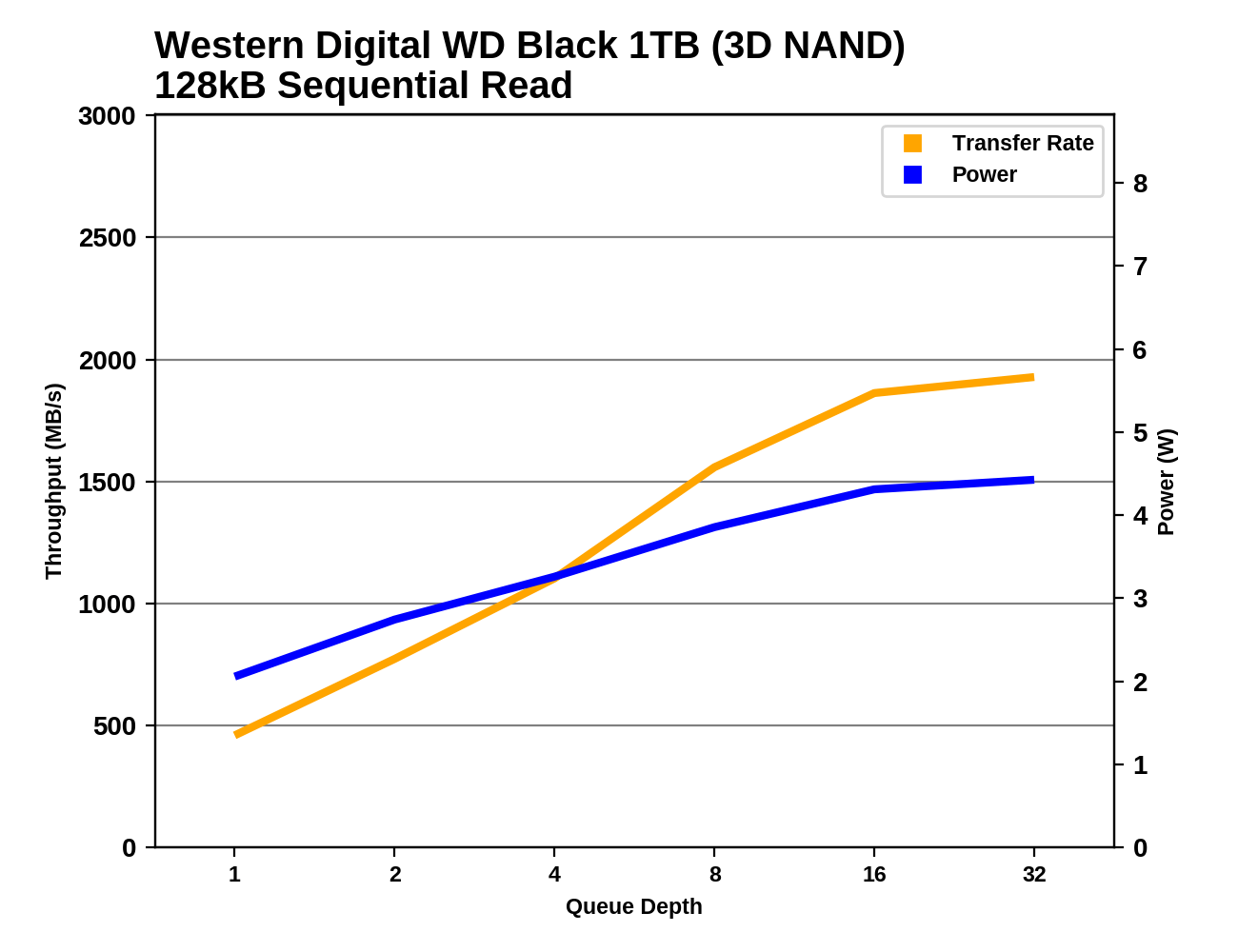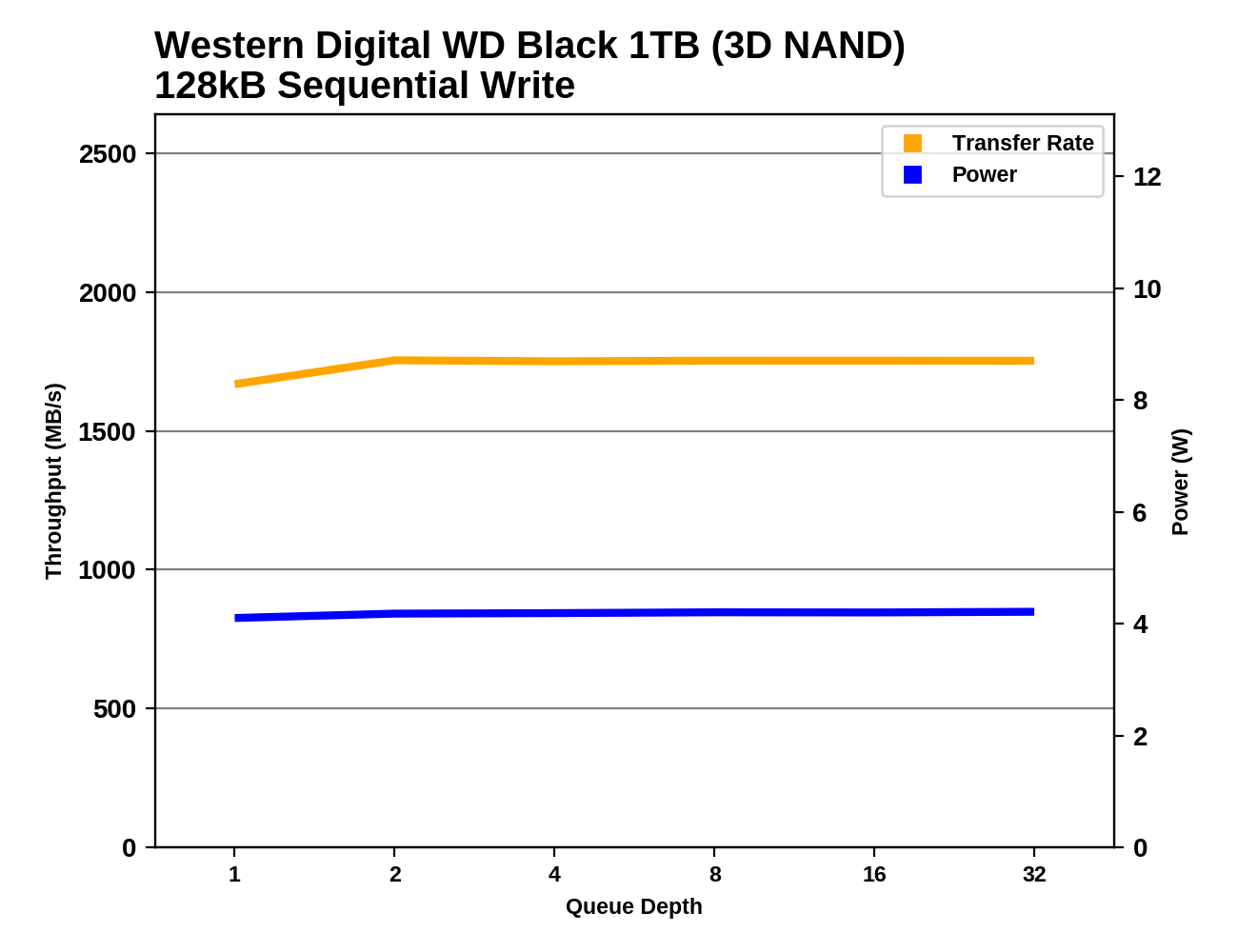The Western Digital WD Black 3D NAND SSD Review: EVO Meets Its Match
by Ganesh T S & Billy Tallis on April 5, 2018 9:45 AM EST- Posted in
- SSDs
- Storage
- Western Digital
- SanDisk
- NVMe
- Extreme Pro
- WD Black
Sequential Read Performance
Our first test of sequential read performance uses short bursts of 128MB, issued as 128kB operations with no queuing. The test averages performance across eight bursts for a total of 1GB of data transferred from a drive containing 16GB of data. Between each burst the drive is given enough idle time to keep the overall duty cycle at 20%.

The burst sequential read performance of the WD Black is several times higher than last year's model, but doesn't come close to setting any records.
Our test of sustained sequential reads uses queue depths from 1 to 32, with the performance and power scores computed as the average of QD1, QD2 and QD4. Each queue depth is tested for up to one minute or 32GB transferred, from a drive containing 64GB of data.

On the sustained sequential read test, the Samsung NVMe drives have a clear lead over the WD Black, which is tied with Toshiba's drives.
 |
|||||||||
| Power Efficiency in MB/s/W | Average Power in W | ||||||||
In terms of power efficiency for sequential reads, the WD Black is much closer to the top drives, with the exception of the Samsung 960 PRO.
 |
|||||||||
The sequential read performance of the WD Black starts out rather poor at QD1 but grows steadily all the way up to QD16, by which point it is outperforming everything except the Optane SSD. The Toshiba XG5 shows similar scaling behavior but can't quite keep pace with the WD Black.
Sequential Write Performance
Our test of sequential write burst performance is structured identically to the sequential read burst performance test save for the direction of the data transfer. Each burst writes 128MB as 128kB operations issued at QD1, for a total of 1GB of data written to a drive containing 16GB of data.

As with the burst random write test, our two samples show surprising differences in burst sequential write speeds. The difference amounts to the WD Black/SanDisk Extreme PRO either being tied for second place with the Samsung 960 EVO, or almost tied with the PM981 that the 960 EVO's replacement will be based on.
Our test of sustained sequential writes is structured identically to our sustained sequential read test, save for the direction of the data transfers. Queue depths range from 1 to 32 and each queue depth is tested for up to one minute or 32GB, followed by up to one minute of idle time for the drive to cool off and perform garbage collection. The test is confined to a 64GB span of the drive.

The sustained sequential write performance of the WD Black is not quite the best, but it is well ahead of everything except the best drives from Samsung and Intel. The WD Black is almost twice as fast as the Toshiba XG5 that uses essentially the same flash.
 |
|||||||||
| Power Efficiency in MB/s/W | Average Power in W | ||||||||
Despite not having the best performance on the sequential write test, the WD Black is the clear winner on the efficiency metric. With power draw of just over 4W it isn't close to being the least power-hungry drive, but it get so much done on that budget that the efficiency score beats everything else.
 |
|||||||||
The sequential write speed of the WD Black is quite steady across the range of queue depths, with just a small increase from QD1 to QD2 and no signs of degraded performance from excessive garbage collection after the SLC cache is full.










69 Comments
View All Comments
FreckledTrout - Friday, April 6, 2018 - link
Since they like sticking to brands they have built like "Black" maybe these should be the new VelociRaptor series? When I here these I think black its 7,200 rpm and the Raptor is 10K rpm.tamalero - Friday, April 6, 2018 - link
They should have renamed the new BLACKs as PLATINUM or TITANIUM. It works.lilmoe - Thursday, April 5, 2018 - link
Ohhh?? Not bad! Still would've preferred if they had undercut Samsung on pricing a significant bit though.Samus - Thursday, April 5, 2018 - link
nCache 3.0's design has me concerned about write thrashing, which killed many Intel SSD's suffering from a bug causing write thrashing in just a few years. The Intel 2500's were chronically plagued with this bug because many OEM's (Lenovo...) never patched them and the drives burned themselves out doing tons of unnecessary house keeping.Hopefully nCache 3.0 has some failsafes.
imaheadcase - Friday, April 6, 2018 - link
It really blows my mind how companies are TERRIBLE at naming products. Its almost like they don't even use common sense for it. Granted these are marketed towards people who most likely are building own systems and what not...but even i'm confused with Intel branding even.At least name product lines based on something that stands out to people to remember.
If i'm not mistaken, isn't Western Digital Black also a platter hardrive as well? Put that into the fact that the article says some of the old versions still be on market even if different sizes..i can easily see someone ordering wrong part.
I miss the days when a CPU was sold based on clock speed alone.
I guess it doesn't help that Aandtech site ventured away from consumer based stuff to more industry based news/reviews.
Drazick - Friday, April 6, 2018 - link
I want this in U.2 or SATA Express format.KAlmquist - Friday, April 6, 2018 - link
At this point I wouldn't be inclined to recommend this drive. The performance reported in this review is good, but:1) It appears that Western Digital is only providing review samples of the 1TB model. For the smaller sizes, the only information we have about performance is the manufacturer's claims.
2) The peculiar branding. Two names for the same drive, both of which are the same as the names of older drives. In particular, a recommendation of the Black drive is likely to result in the person getting an older, slower drive.
3) The drive was just released so it has no track record.
JWKauffman - Friday, April 6, 2018 - link
I'm curious why WD apparently isn't supplying an NVMe driver to optimize their controller. I think the question should have been raised in the review.tamalero - Friday, April 6, 2018 - link
Most third party companies do not offer any kind of driver. They rely on Windows's.I have a Corsair MP500, same issue.
JWKauffman - Friday, April 6, 2018 - link
I understand that, but if I were WD and positioning these drives as Samsung competitors, I'd want to have a driver tailored to my controller the same as Samsung does.